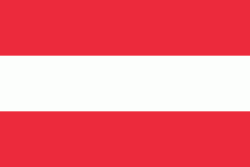Steinbach an der Steyr (Steinbach an der Steyr)
Steinbach an der Steyr is a municipality in the district of Kirchdorf an der Krems in the Austrian state of Upper Austria.
Steinbach is in the valley of the river Steyr. It is 381 m above sea level and 20 km south of the town Steyr. 36.0% of its area is wood, 53.7% of the area is used for agriculture. The highest hill is the Hochbuchberg (1273 m). The nearby lodge Grünburger Hütte is 1080 m. The community area is divided into four subparts: Steinbach, Pieslwang, Forstau and Zehetner. Nearby communities are Grünburg, Ternberg, Aschach an der Steyr, Waldneukirchen and Molln.
The river Steyr on the west side of the community is embedded in deep carved gravel terraces with a few sand banks. The canyon is mostly natural and the water quality is excellent. Its cold temperature of 16 C maximum and strong currents make the shallow river dangerous at several sections.
Steinbach is in the valley of the river Steyr. It is 381 m above sea level and 20 km south of the town Steyr. 36.0% of its area is wood, 53.7% of the area is used for agriculture. The highest hill is the Hochbuchberg (1273 m). The nearby lodge Grünburger Hütte is 1080 m. The community area is divided into four subparts: Steinbach, Pieslwang, Forstau and Zehetner. Nearby communities are Grünburg, Ternberg, Aschach an der Steyr, Waldneukirchen and Molln.
The river Steyr on the west side of the community is embedded in deep carved gravel terraces with a few sand banks. The canyon is mostly natural and the water quality is excellent. Its cold temperature of 16 C maximum and strong currents make the shallow river dangerous at several sections.
Map - Steinbach an der Steyr (Steinbach an der Steyr)
Map
Country - Austria
 |
 |
| Flag of Austria | |
Austria emerged from the remnants of the Eastern and Hungarian March at the end of the first millennium. Originally a margraviate of Bavaria, it developed into a duchy of the Holy Roman Empire in 1156 and was later made an archduchy in 1453. In the 16th century, Vienna began serving as the empire's administrative capital and Austria thus became the heartland of the Habsburg monarchy. After the dissolution of the Holy Roman Empire in 1806, Austria established its own empire, which became a great power and the dominant member of the German Confederation. The empire's defeat in the Austro-Prussian War of 1866 led to the end of the Confederation and paved the way for the establishment of Austria-Hungary a year later.
Currency / Language
| ISO | Currency | Symbol | Significant figures |
|---|---|---|---|
| EUR | Euro | € | 2 |
| ISO | Language |
|---|---|
| HR | Croatian language |
| DE | German language |
| HU | Hungarian language |
| SL | Slovene language |















